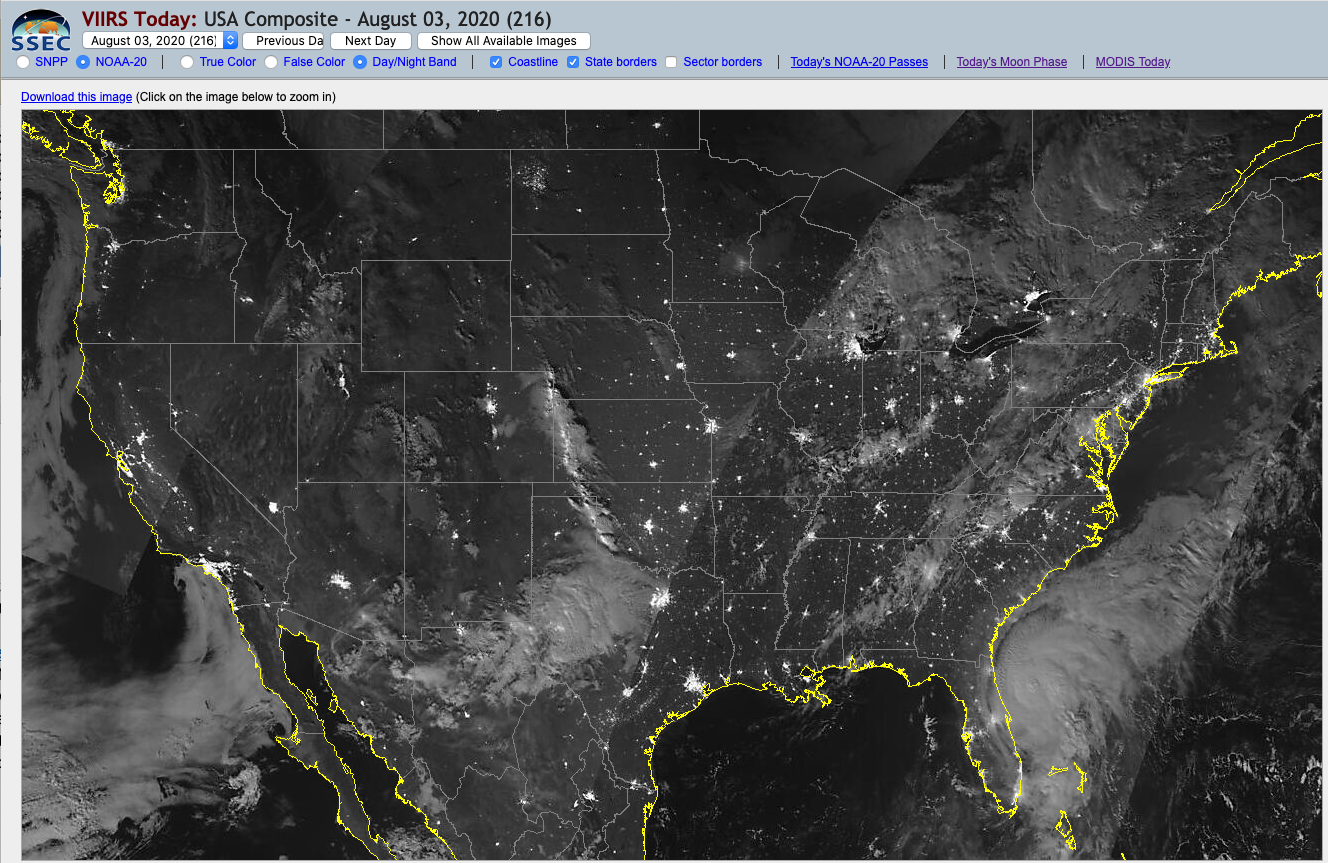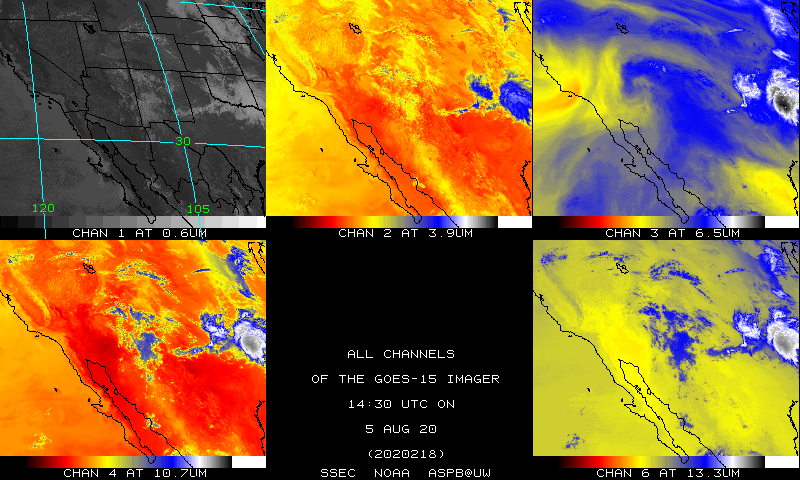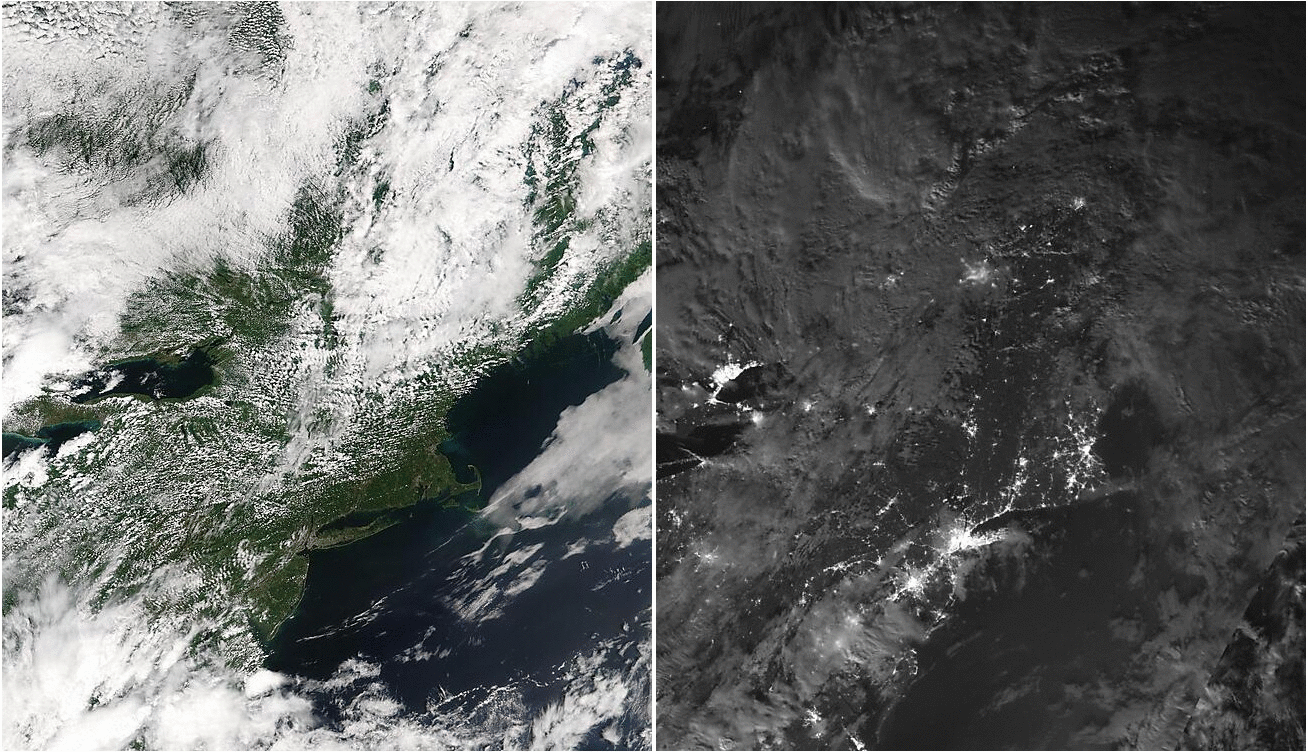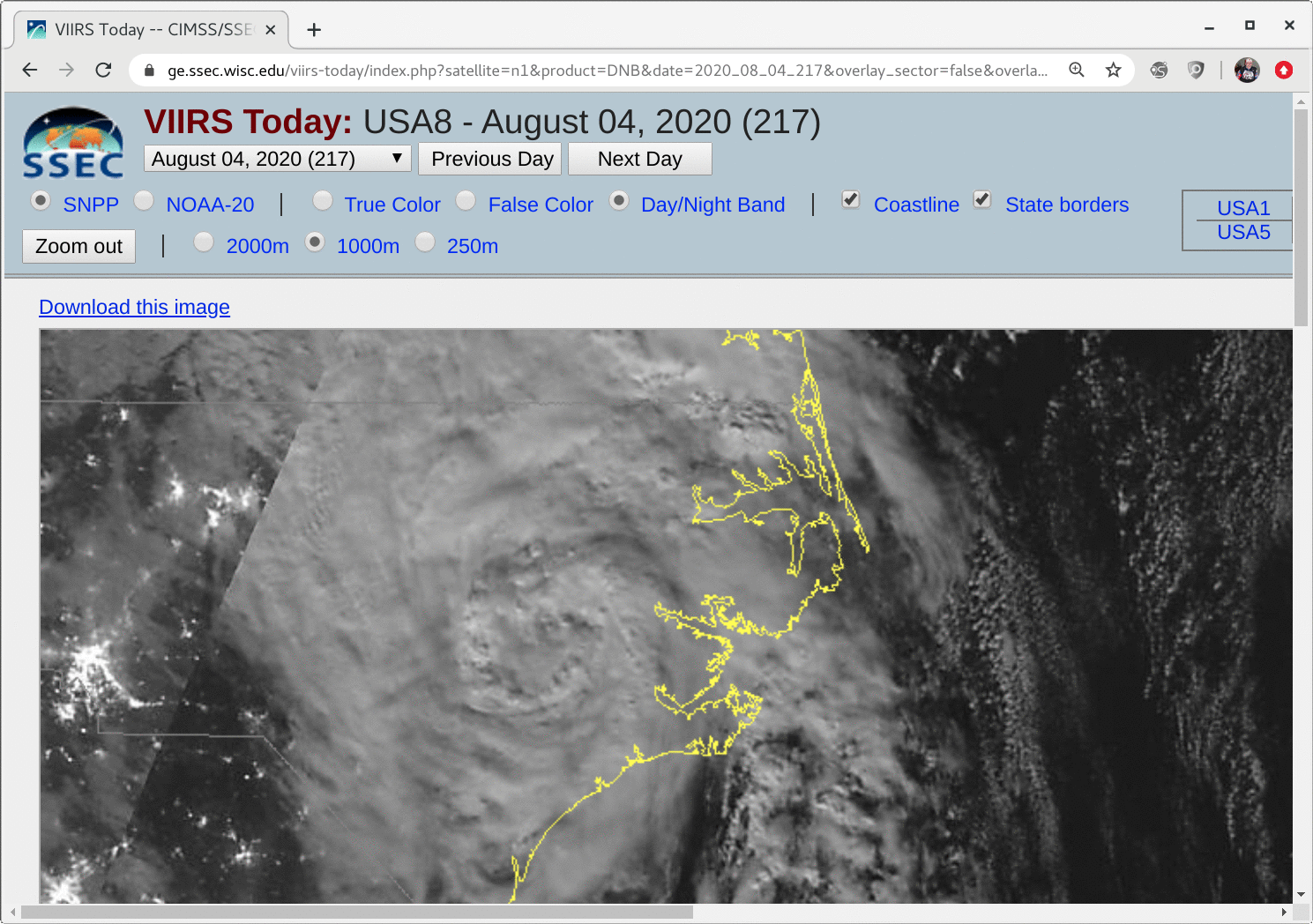
[ Archive ]

 |
CIMSS-NOAA Weekly Report [ Archive ] |
 |
CIMSS AND ASPB WEEKLY HIGHLIGHTS FOR THE WEEK ENDING AUGUST 7, 2020
PRODUCTS AND APPLICATIONS:
VIIRS Today Website Launch: The Community Satellite Processing Package (CSPP) team at the University of Wisconsin -Madison CIMSS launched the Joint Polar Satellite System (JPSS) Visible Infrared Imaging Radiometer Suite (VIIRS) Today website providing a near-real-time, high-resolution interface to satellite imagery - https://ge.ssec.wisc.edu/viirs-today/. This site provides an easy to navigate display of Suomi-National Polar-orbiting Partnership (S-NPP) and NOAA-20 VIIRS true color, false color and Day/Night Band imagery over fixed tiles covering the Contiguous United States (CONUS) and offshore waters. Users can drill down to view imagery at 2km, 1km and about 250m spatial resolution for each tile, making it consistent with the popular MODIS Today page. New passes are overlaid as they are acquired and processed locally using CSPP direct broadcast software. (K. Strabala, CIMSS, 608-263-8752)
 (Click image to enlarge)
(Click image to enlarge)
Figure: VIIRS Today website showing NOAA-20 VIIRS Day/Night Band over CONUS overnight on 3 August 2020. The website address is https://ge.ssec.wisc.edu/viirs-today/.
GOES-15 Imager GVAR Acquired: Beginning on the afternoon of 4 August 4 2020, the University of Wisconsin-Madison Space Science and Engineering Center (SSEC) Data Services was able to acquire the GOES-15 imager GVAR (GOES Variable) signal. This was in preparation for the supplemental operations of the GOES-15 Imager between August 9 and September 3, 2020. Details are available at https://www.ospo.noaa.gov/data/messages/2020/MSG184170402.html or https://www.ssec.wisc.edu/datacenter/dcmain.html. A qualitative analysis of the GOES-15 imagery was presented to the Calibration Working Group on August 5. The data quality was as expected. (T. Schmit, E/RA2, 608-263-0291, tim.j.schmit@noaa.gov; M. Gunshor, CIMSS, 608-263-1146; J. Robaidek, SSEC Data Services)
 (Click image to enlarge)
(Click image to enlarge)
Figure: A GOES-15 Imager multi-panel image from August 5, 2020 at 14:30 UTC. The five spectral bands of the legacy imager are shown over a portion of their coverage area. GOES-15 is located at 128 West.
AWARDS AND RECOGNITION:
PUBLICATIONS:
BAMS Early Release Article on a CIMSS-AOS Climate Change Course: A new article in the Bulletin of the American Meteorological Society (BAMS) recounts the history, evolution and efficacy of an on-line course on Climate and Climate Change offered each summer through the University of Wisconsin-Madison's Department of Atmospheric and Oceanic Sciences (AOS). The undergraduate course is the culmination of two NASA education grants awarded to NOAA’s Cooperative Institute for Meteorological Satellite Studies (CIMSS) and co-taught by former CIMSS Director and AOS professor Steve Ackerman and Margaret Mooney from CIMSS. Several years of pre- and post-course survey responses were analyzed by Andrew Dzambo, a 2019 teaching assistant and lead author on the BAMS article, available via Early Online Release at https://doi.org/10.1175/BAMS-D-19-0271.1. (M. Mooney, CIMSS, margaret.mooney@ssec.wisc.edu, S. Ackerman, CIMSS, S. Lindstrom, CIMSS)
WORKSHOPS, CONFERENCES, AND MEETINGS:
TRAINING AND EDUCATION:
Quick Guides created for GOES-16 Fog/Low Stratus Products: GOES-16 Fog/Low Stratus products will shortly be distributed to National Weather Service forecast offices via the Satellite Broadcast Network (SBN). In preparation for that, short (1- or 2-page) “Quick Guides” for the products have been created at the Cooperative Institute for Meteorological Satellite Studies (CIMSS). These products will be available to those forecasters via NOAA’s Virtual Lab (vlab) STOR (Satellite Training Operational Resource). They are also available at this CIMSS website: http://cimss.ssec.wisc.edu/goes/GOESR_QuickGuides.html. The Quick Guides were developed at CIMSS in collaboration with the Forecast Decision Training Division (FDTD) and the Office of the Chief Learning Officer (OCLO) (S. Lindstrom, CIMSS, 608 263 4425; Corey Calvert, CIMSS)
MEDIA AND OUTREACH:
SSEC and CIMSS Scientists in the News: Scientists at the University of Wisconsin-Madison (UW) Space Science and Engineering Center (SSEC) and the Cooperative Institute for Meteorological Satellite Studies (CIMSS) provide expert commentary, interviews, and imagery to news media and participate in events to promote science. In the news this week: CIMSS Satellite Blog contributors Scott Lindstrom and Scott Bachmeier published posts on "Creating sector-spanning imagery from VIIRS today imagery" (Aug. 5), "Fire signatures following a large explosion in Beirut, Lebanon" (Aug. 4), "VIIRS Today Website is live" (Aug. 4), "Isaias re-intensifies to a Hurricane" (Aug. 3), "Heavy rainfall across Interior Alaska" (Aug. 2), and "1 week of volcanic cloud emission from Nishioshima" (Aug. 1). Read more: https://cimss.ssec.wisc.edu/satellite-blog/. (J. Phillips, SSEC, 608-262-8164, S. Lindstrom, CIMSS, S. Bachmeier, CIMSS, 608-263-3958)
 (Click image to enlarge)
(Click image to enlarge)
Figure: CIMSS launched the VIIRS Today website on Aug. 4, 2020, a follow-on to the popular MODIS Today site. Above: Suomi NPP, true-color and false-color imagery from Aug. 3, 2020 over the northeast United States, paired with NOAA-20, Day Night Band imagery, also from Aug. 3.
 (Click image to enlarge)
(Click image to enlarge)
Figure: Images of Hurricane Isaias moving inland after its landfall in North Carolina on Aug. 4, 2020. Credit: CIMSS, VIIRS Today.
OTHER:
| Archived Weeklies Page | Submit a report item |